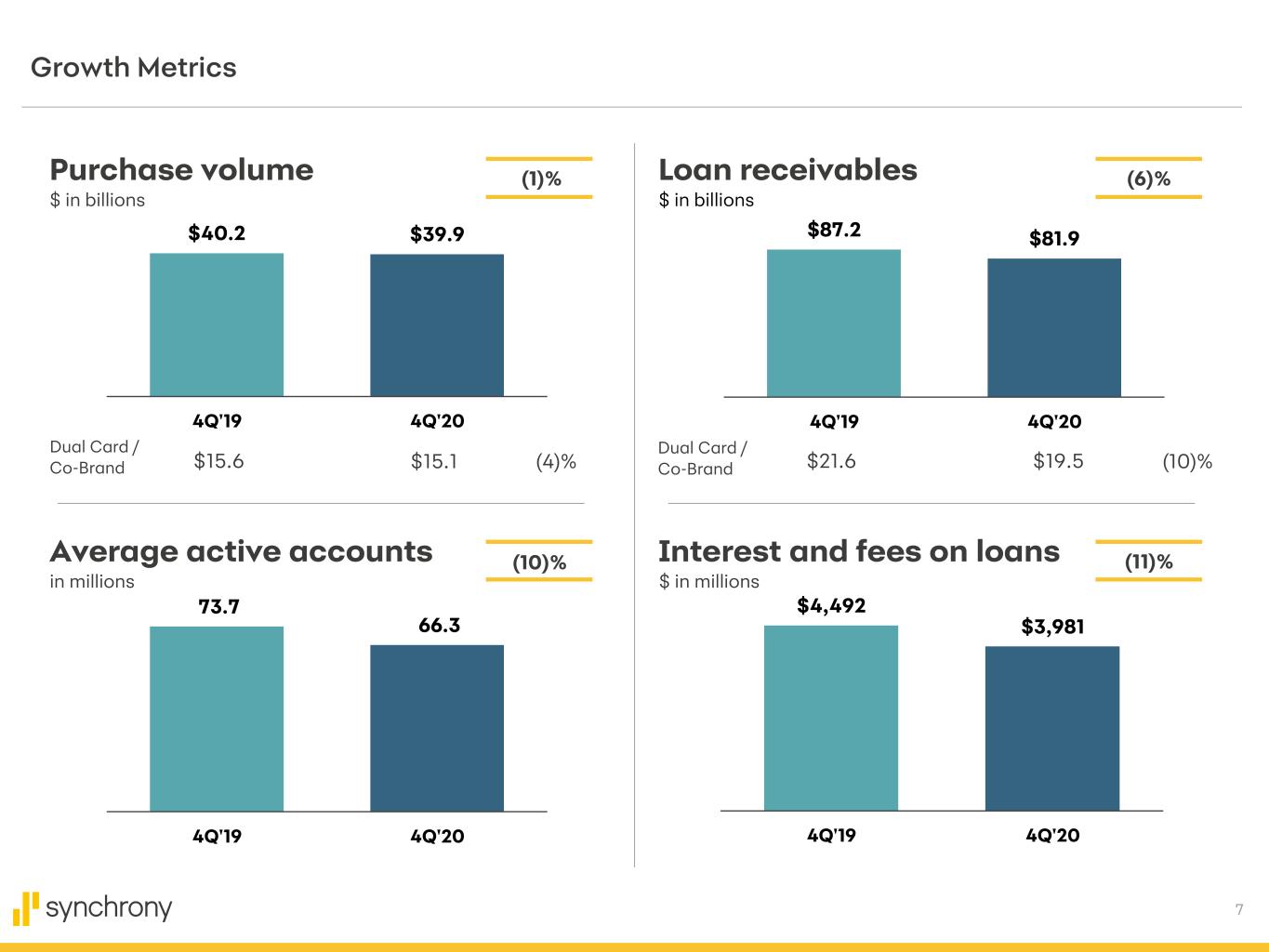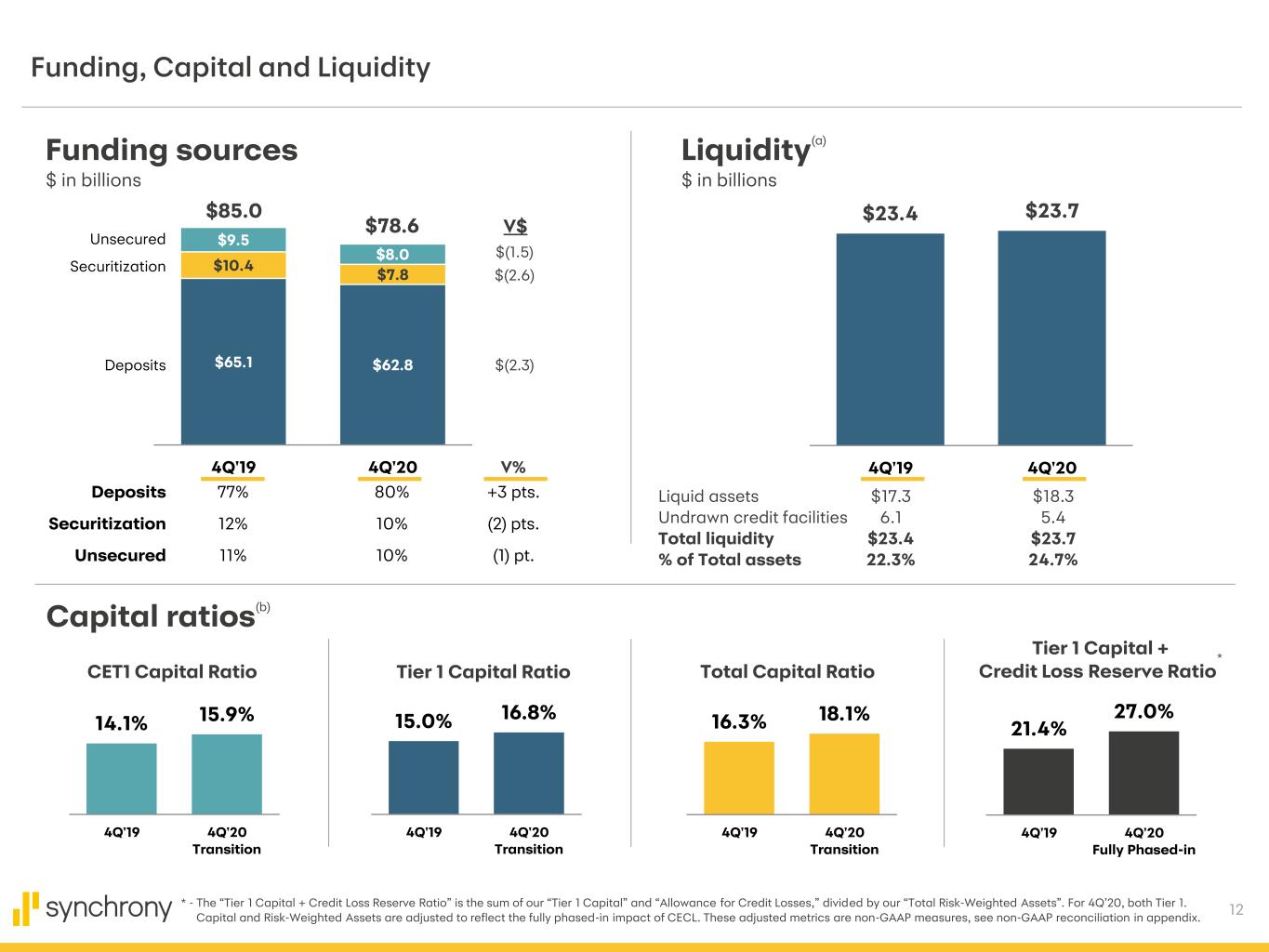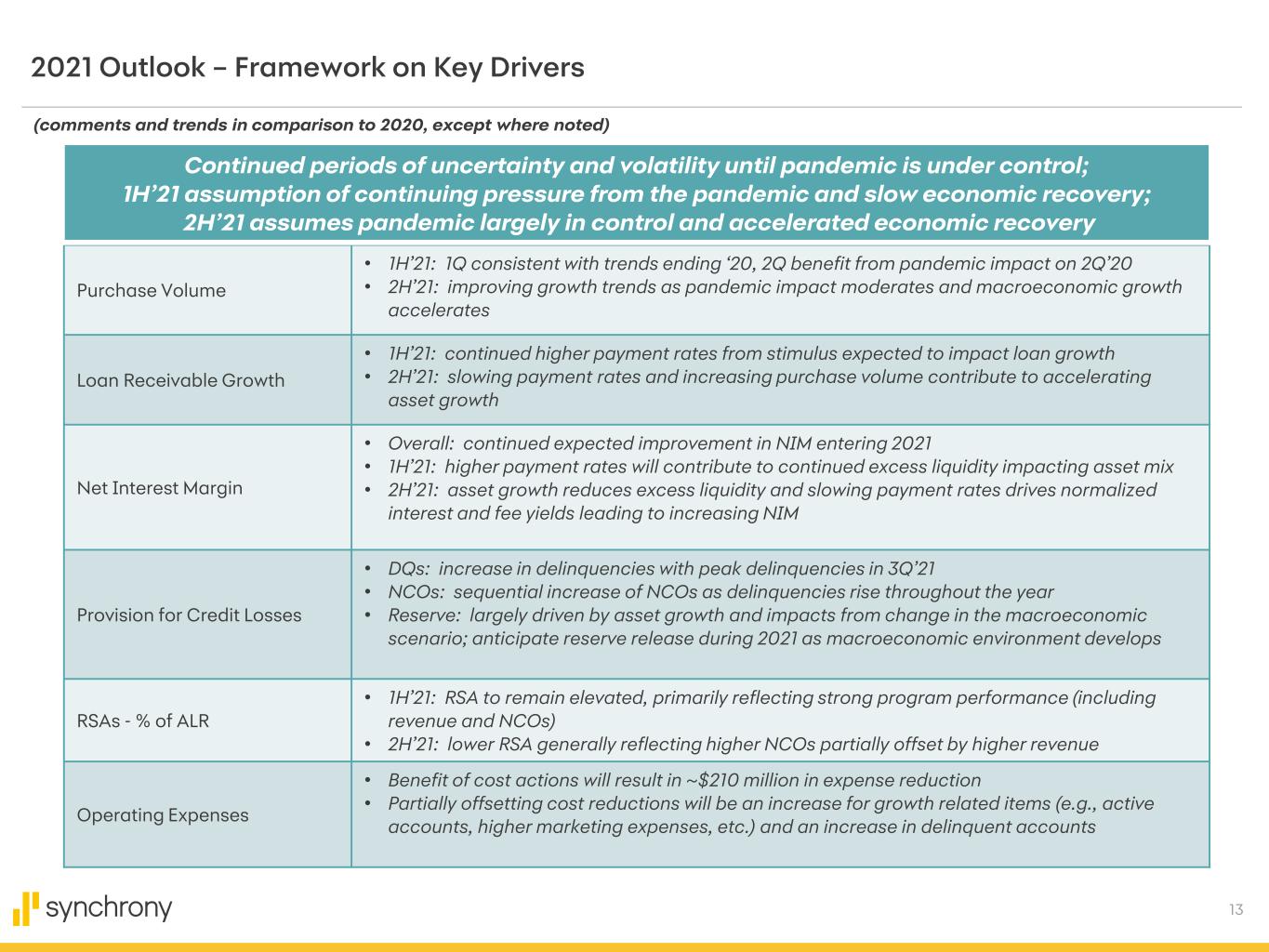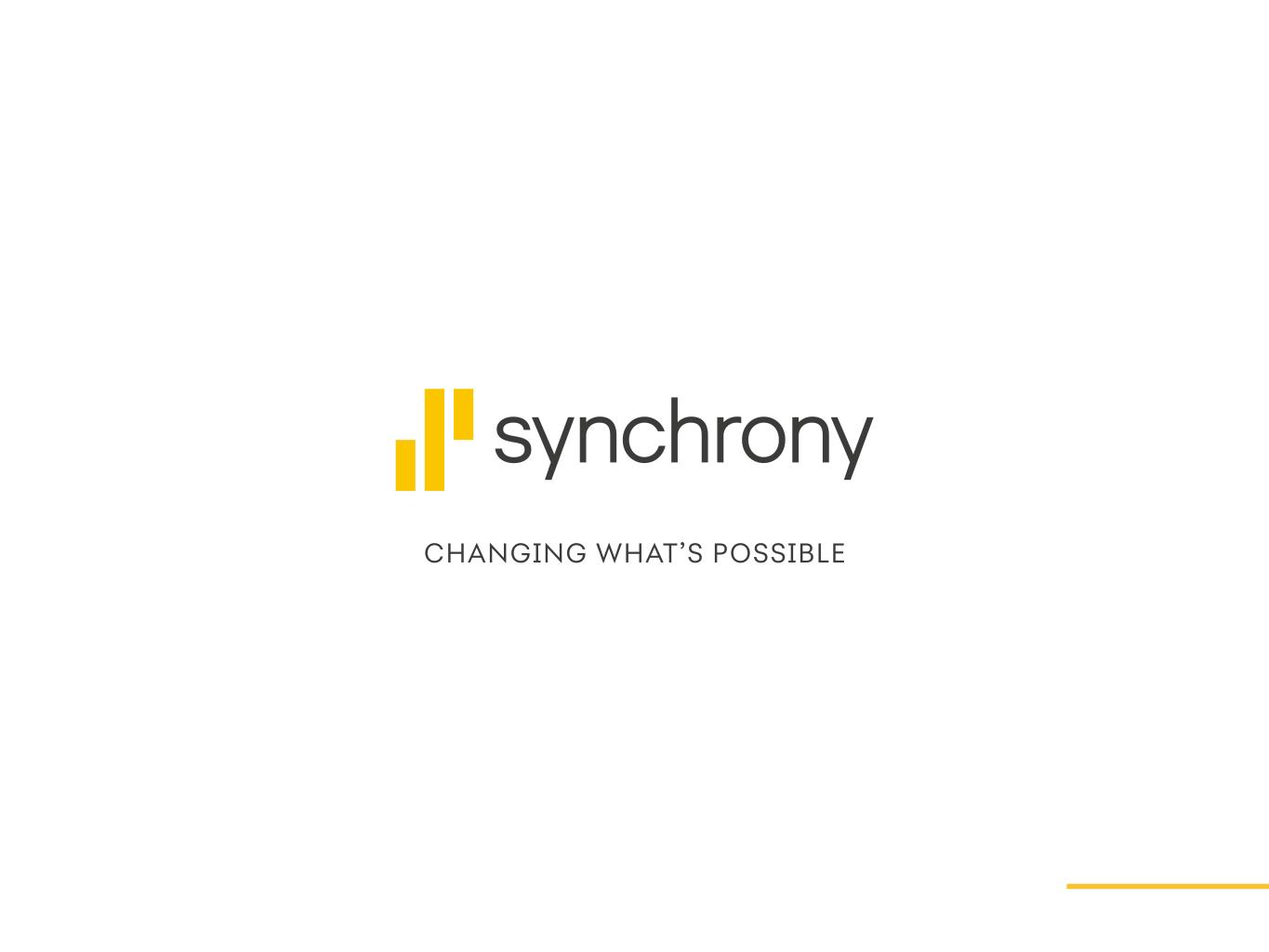Attached files
| file | filename |
|---|---|
| EX-99.4 - EX-99.4 - Synchrony Financial | non-gaapmeasures4q20.htm |
| EX-99.2 - EX-99.2 - Synchrony Financial | financialtables4q20.htm |
| EX-99.1 - EX-99.1 - Synchrony Financial | earningsrelease4q20.htm |
| 8-K - 8-K - Synchrony Financial | syf-20210129.htm |

4Q’20 FINANCIAL RESULTS J A N U A R Y 2 9 , 2 0 2 1 Exhibit 99.3

2 Cautionary Statement Regarding Forward-Looking Statements The following slides are part of a presentation by Synchrony Financial in connection with reporting quarterly financial results. No representation is made that the information in these slides is complete. For additional information, see the earnings release and financial supplement included as exhibits to our Current Report on Form 8-K filed today and available on our website (www.synchronyfinancial.com) and the SEC's website (www.sec.gov). All references to net earnings and net income are intended to have the same meaning. All comparisons are for the fourth quarter of 2020 compared to the fourth quarter of 2019, unless otherwise noted. This presentation contains certain forward-looking statements as defined in Section 27A of the Securities Act of 1933, as amended, and Section 21E of the Securities Exchange Act of 1934, as amended, which are subject to the "safe harbor" created by those sections. Forward-looking statements may be identified by words such as "expects," "intends," "anticipates," "plans," "believes," "seeks," "targets," "outlook," "estimates," "will," "should," "may" or words of similar meaning, but these words are not the exclusive means of identifying forward-looking statements. Forward- looking statements are based on management's current expectations and assumptions, and are subject to inherent uncertainties, risks and changes in circumstances that are difficult to predict. As a result, actual results could differ materially from those indicated in these forward-looking statements. Factors that could cause actual results to differ materially include global political, economic, business, competitive, market, regulatory and other factors and risks, such as: the impact of macroeconomic conditions and whether industry trends we have identified develop as anticipated, including the future impacts of the novel coronavirus disease (“COVID-19”) outbreak and measures taken in response thereto for which future developments are highly uncertain and difficult to predict; retaining existing partners and attracting new partners, concentration of our revenue in a small number of Retail Card partners, and promotion and support of our products by our partners; cyber-attacks or other security breaches; disruptions in the operations of our computer systems and data centers; the financial performance of our partners; the sufficiency of our allowance for credit losses and the accuracy of the assumptions or estimates used in preparing our financial statements, including those related to the new CECL accounting guidance; higher borrowing costs and adverse financial market conditions impacting our funding and liquidity, and any reduction in our credit ratings; our ability to grow our deposits in the future; damage to our reputation; our ability to securitize our loan receivables, occurrence of an early amortization of our securitization facilities, loss of the right to service or subservice our securitized loan receivables, and lower payment rates on our securitized loan receivables; changes in market interest rates and the impact of any margin compression; effectiveness of our risk management processes and procedures, reliance on models which may be inaccurate or misinterpreted, our ability to manage our credit risk; our ability to offset increases in our costs in retailer share arrangements; competition in the consumer finance industry; our concentration in the U.S. consumer credit market; our ability to successfully develop and commercialize new or enhanced products and services; our ability to realize the value of acquisitions and strategic investments; reductions in interchange fees; fraudulent activity; failure of third parties to provide various services that are important to our operations; international risks and compliance and regulatory risks and costs associated with international operations; alleged infringement of intellectual property rights of others and our ability to protect our intellectual property; litigation and regulatory actions; our ability to attract, retain and motivate key officers and employees; tax legislation initiatives or challenges to our tax positions and/or interpretations, and state sales tax rules and regulations; a material indemnification obligation to GE under the Tax Sharing and Separation Agreement with GE if we cause the split-off from GE or certain preliminary transactions to fail to qualify for tax-free treatment or in the case of certain significant transfers of our stock following the split-off; regulation, supervision, examination and enforcement of our business by governmental authorities, the impact of the Dodd-Frank Wall Street Reform and Consumer Protection Act and other legislative and regulatory developments and the impact of the Consumer Financial Protection Bureau’s regulation of our business; impact of capital adequacy rules and liquidity requirements; restrictions that limit our ability to pay dividends and repurchase our common stock, and restrictions that limit the Synchrony Bank’s ability to pay dividends to us; regulations relating to privacy, information security and data protection; use of third-party vendors and ongoing third-party business relationships; and failure to comply with anti-money laundering and anti-terrorism financing laws. For the reasons described above, we caution you against relying on any forward-looking statements, which should also be read in conjunction with the other cautionary statements that are included elsewhere in this presentation and in our public filings, including under the heading "Risk Factors" in the Company's Annual Report on Form 10-K for the fiscal year ended December 31, 2019, as filed on February 13, 2020, and the Company’s Quarterly Report on Form 10-Q for the quarter ended September 30, 2020, as filed on October 22, 2020. You should not consider any list of such factors to be an exhaustive statement of all the risks, uncertainties, or potentially inaccurate assumptions that could cause our current expectations or beliefs to change. Further, any forward-looking statement speaks only as of the date on which it is made, and we undertake no obligation to update or revise any forward-looking statement to reflect events or circumstances after the date on which the statement is made or to reflect the occurrence of unanticipated events, except as otherwise may be required by law. Disclaimers

3 $1.24 DILUTED EPS Full Year EPS of $2.27 14.64% NET INTEREST MARGIN compared to 15.01% 15.9% CET1 liquid assets of $18.3 billion, 19.1% of total assets SUMMARY FINANCIAL METRICS CAPITAL 4Q’20 Financial Highlights $81.9 billion LOAN RECEIVABLES compared to $87.2 billion 66.3 million AVERAGE ACTIVE ACCOUNTS compared to 73.7 million $128 million CAPITAL RETURNED $1.5 billion in total capital returned for 2020 $62.8 billion DEPOSITS compared to $65.1 billion, 80% of current funding 3.16% NET CHARGE-OFFS compared to 5.15% 37.1% EFFICIENCY RATIO compared to 34.8%

4 4Q’20 Business Highlights ~60% DIGITAL APPLICATIONS* *Percentage of Total Applications 51% ONLINE SALES* *Percentage of Retail Card Total ~65% DIGITAL PAYMENTS* *4Q20 % of Total Payments 18% Mobile Channel Application Growth 9 RENEWALS 7 NEW DEALS 1 ACQUISITION PARTNER EXPANSION CONSUMER PERFORMANCE DIGITAL ACCELERATION 7.5 6.1 4Q'19 4Q'20 $545 $602 4Q'19 4Q'20 $1,158 $1,199 4Q'19 4Q'20 (19)% 10% 4% (21)%YTD 25.6 20.2 New Accounts Purchase Volume per Account Average Balance per Account (a) (b) (c)

5 Equal Payment Financing Strategy Revolving Products Delivering broader choice in financing to meet the evolving needs of our partners and customers PARTNER AND CUSTOMER NEEDS PRODUCT STRATEGY Closed End Products • Mid & Long-Term Equal Payment Plans (12 – 162 mos. / APRs start at 0%) • Collateralized Installments (Secured) (12 – 180 mos. / APRs start at 0%) • Short & Long-Term Installments (3 – 36 mos. / APRs start at 0%) Partners • Seamless Integration • Higher Average Order Value and Sales • Increased Conversion Rate • Product flexibility to manage merchant costs $15 billion TOTAL equal payment balances as of December 2020 ~74,000 PARTNERS AND/OR LOCATIONS of payment plan products 66% 0% APR FINANCING 2020 YTD ~30% REPEAT PURCHASES within 24 months at participating partners • Short Term Equal Payment Plans (3 – 12 mos. / APRs start at 0%) Customers • Affordability • Transparency • Ease and Convenience • Flexibility • Control (a) (b)

6 Total interest income $3,993 $4,585 $(592) (13)% Total interest expense 334 556 222 40% Net interest income (NII) 3,659 4,029 (370) (9)% Retailer share arrangements (RSA) (1,047) (1,029) (18) (2)% Provision for credit losses 750 1,104 354 32% Other income 82 104 (22) (21)% Other expense 1,000 1,079 79 7% Pre-tax earnings 944 921 23 2% Provision for income taxes 206 190 (16) (8)% Net earnings 738 731 7 1% Preferred dividends 10 0 (10) NM Net earnings available to common $728 $731 $(3) (0)% stockholders Diluted earnings per share $1.24 $1.15 $0.09 Financial Results $ in millions, except per share statistics B/(W) • $738 million Net earnings, $1.24 diluted EPS • Net interest income down 9% − Interest and fees on loans down 11% driven by the impact of COVID-19 − Interest expense decrease driven primarily by lower benchmark rates • Provision for credit losses down 32% −Decrease is primarily driven by lower net charge- offs −Net charge-offs of 3.16% compared to 5.15% in the prior year primarily driven by the impact of improvements in customer payment behavior • Other expense down 7% −Decrease primarily due to lower purchase volume and accounts, lower employee costs, and lower operational losses 4Q’20 Highlights Summary earnings statement 4Q’20 4Q’19 $ %

7 $4,492 $3,981 4Q'19 4Q'20 $87.2 $81.9 4Q'19 4Q'20 $40.2 $39.9 4Q'19 4Q'20 73.7 66.3 4Q'19 4Q'20 (1)%Purchase volume $ in billions Loan receivables $ in billions Average active accounts in millions (10)% (11)% (6)% Interest and fees on loans $ in millions $94.0 $4,686 $44.0 75.1 Dual Card / Co-Brand $15.6 (10)%(4)% Dual Card / Co-Brand$15.1 $21.6 $19.5 Growth Metrics

8 $20.2 $20.5 4 Q '2 0 4 Q '1 9 $52.1 $56.4 4 Q '2 0 4 Q '1 9 Platform Results CareCredit Loan receivables, $ in billions (7)% $9.6 $10.3 4 Q '2 0 4 Q '1 9 • Receivable reduction primarily due to COVID-19 • Interest and fees on loans down 4% driven primarily by lower merchant discount resulting from lower purchase volume Payment Solutions Loan receivables, $ in billions (2)% • Receivable reduction primarily due to COVID-19 partially offset by growth in Power Sports and Home Specialty • Interest and fees on loans down 9% driven primarily by lower yield on loan receivables Retail Card Loan receivables, $ in billions (8)% • Receivable reduction primarily due to COVID-19 partially offset by growth in digital partners • Interest and fees on loans down 13% driven primarily by COVID-19 and the decline in loan receivables Accounts $31.0 54.6 $3,143 $31.3 49.1 $2,719 1% (10)% (13)% V% Purchase volume Interest and fees on loans 4Q’204Q’19 $6.4 12.7 $737 $5.9 11.5 $673 (7)% (9)% (9)% V%4Q’204Q’19 Purchase volume Accounts Interest and fees on loans $2.8 6.4 $612 $2.7 5.7 $589 (6)% (10)% (4)% V%4Q’204Q’19 Purchase volume Accounts Interest and fees on loans Accounts (a)

9 Net Interest Income Net interest income $ in millions % of average interest-earning assets (9)% • Net interest income decreased 9% − Interest and fees on loans decreased 11% compared to prior year primarily driven by the impact of COVID-19 • Net interest margin (NIM) down 37bps. −Mix of Interest-earnings assets: (0.05)% − Loan receivables mix as a percent of total Earning Assets decreased from 80.2% to 79.9% − Loan receivables yield: (0.75)% − Loan receivables yield of 19.93%, down 94bps. − Liquidity portfolio yield: (0.30)% − Interest-bearing liabilities cost: 0.73% −Total cost decreased 89bps. to 1.69% due primarily to lower benchmark rates and higher proportion of deposit funding 4Q’20 Highlights $4,029 $3,659 15.01% 14.64% 4Q'19 4Q'20 4Q’19 NIM 15.01% Mix of Interest-earning assets (0.05)% Loan receivables yield (0.75)% Liquidity portfolio yield (0.30)% Interest-bearing liabilities cost 0.73% 4Q’20 NIM 14.64% NIM walk

10 Asset Quality Metrics Allowance for credit losses $ in millions, % of period-end loan receivables $4,430 $3,957 $3,625 $3,723 $3,874 $3,500 $2,453 $2,100 $2,514 4.76% 4.92% 4.43% 4.47% 4.44% 4.24% 3.13% 2.67% 3.07% 4Q'18 1Q'19 2Q'19 3Q'19 4Q'19 1Q'20 2Q'20 3Q'20 4Q'20 $1,248 $1,344 $1,331 $1,221 $1,109 $1,125 $1,046 $866 $631 5.54% 6.06% 6.01% 5.35% 5.15% 5.36% 5.35% 4.42% 3.16% 4Q'18 1Q'19 2Q'19 3Q'19 4Q'19 1Q'20 2Q'20 3Q'20 4Q'20 Net charge-offs $ in millions, % of average loan receivables including held for sale 30+ days past due $ in millions, % of period-end loan receivables $2,135 $2,019 $1,768 $1,723 $1,877 $1,735 $1,384 $973 $1,143 2.29% 2.51% 2.16% 2.07% 2.15% 2.10% 1.77% 1.24% 1.40% 4Q'18 1Q'19 2Q'19 3Q'19 4Q'19 1Q'20 2Q'20 3Q'20 4Q'20 90+ days past due $ in millions, % of period-end loan receivables $6,427 $5,942 $5,809 $5,607 $5,602 $9,175 $9,802 $10,146 $10,265 6.90% 7.39% 7.10% 6.74% 6.42% 11.13% 12.52% 12.92% 12.54% 4Q'18 1Q'19 2Q'19 3Q'19 4Q'19 1Q'20 2Q'20 3Q'20 4Q'20 (a)

11 Other Expense $1,079 $1,000 4Q'19 4Q'20 Other expense $ in millions (7)% Other expense down 7% • Decrease primarily due to lower purchase volume and accounts, lower employee costs, and lower operational losses Efficiency ratio 37.1% vs. 34.8% prior year • Increase in ratio driven by decrease in revenue partially offset by lower employee costs and lower operational losses V$ V% Employee costs $385 $347 $(38) (10)% Professional fees 199 186 (13) (7)% Marketing/BD 152 139 (13) (9)% Information processing 122 128 6 5% Other 221 200 (21) (10)% Other expense $1,079 $1,000 $(79) (7)% Efficiency(a) 34.8% 37.1% 2.3 pts. 4Q’19 4Q’20 4Q’20 Highlights

12 Funding, Capital and Liquidity Funding sources $ in billions Deposits Securitization Unsecured $65.1 $62.8 $10.4 $7.8 $9.5 $8.0 4Q'19 4Q'20 $85.0 $78.6 Deposits Securitization Unsecured V$ $(1.5) $(2.6) $(2.3) V% Liquidity (a) $ in billions $23.4 $23.7 4Q'19 4Q'20 Liquid assets Undrawn credit facilities Total liquidity % of Total assets CET1 Capital Ratio 14.1% 15.9% 4Q'19 4Q'20 Transition Tier 1 Capital Ratio 15.0% 16.8% 4Q'19 4Q'20 Transition Total Capital Ratio 16.3% 18.1% 4Q'19 4Q'20 Transition Tier 1 Capital + Credit Loss Reserve Ratio * 21.4% 27.0% 4Q'19 4Q'20 Fully Phased-in Capital ratios (b) 77% 12% 11% 80% 10% 10% +3 pts. (2) pts. (1) pt. $17.3 6.1 $23.4 22.3% $18.3 5.4 $23.7 24.7% * - The “Tier 1 Capital + Credit Loss Reserve Ratio” is the sum of our “Tier 1 Capital” and “Allowance for Credit Losses,” divided by our “Total Risk-Weighted Assets”. For 4Q’20, both Tier 1. Capital and Risk-Weighted Assets are adjusted to reflect the fully phased-in impact of CECL. These adjusted metrics are non-GAAP measures, see non-GAAP reconciliation in appendix.

13 2021 Outlook – Framework on Key Drivers Purchase Volume • 1H’21: 1Q consistent with trends ending ‘20, 2Q benefit from pandemic impact on 2Q’20 • 2H’21: improving growth trends as pandemic impact moderates and macroeconomic growth accelerates Loan Receivable Growth • 1H’21: continued higher payment rates from stimulus expected to impact loan growth • 2H’21: slowing payment rates and increasing purchase volume contribute to accelerating asset growth Net Interest Margin • Overall: continued expected improvement in NIM entering 2021 • 1H’21: higher payment rates will contribute to continued excess liquidity impacting asset mix • 2H’21: asset growth reduces excess liquidity and slowing payment rates drives normalized interest and fee yields leading to increasing NIM Provision for Credit Losses • DQs: increase in delinquencies with peak delinquencies in 3Q’21 • NCOs: sequential increase of NCOs as delinquencies rise throughout the year • Reserve: largely driven by asset growth and impacts from change in the macroeconomic scenario; anticipate reserve release during 2021 as macroeconomic environment develops RSAs - % of ALR • 1H’21: RSA to remain elevated, primarily reflecting strong program performance (including revenue and NCOs) • 2H’21: lower RSA generally reflecting higher NCOs partially offset by higher revenue Operating Expenses • Benefit of cost actions will result in ~$210 million in expense reduction • Partially offsetting cost reductions will be an increase for growth related items (e.g., active accounts, higher marketing expenses, etc.) and an increase in delinquent accounts Continued periods of uncertainty and volatility until pandemic is under control; 1H’21 assumption of continuing pressure from the pandemic and slow economic recovery; 2H’21 assumes pandemic largely in control and accelerated economic recovery (comments and trends in comparison to 2020, except where noted)

14 Footnotes (a) New Accounts represent accounts that were approved in the respective period, in millions. (b) Purchase Volume per Account is calculated as the Purchase volume divided by Average active accounts, in $. (c) Average Balance per Account is calculated as the Average loan receivables divided by Average active accounts, in $. 4Q’20 Business Highlights | slide 4: Platform Results | slide 8: (a) Accounts represent average active accounts in millions, which are credit card or installment loan accounts on which there has been a purchase, payment or outstanding balance in the current month. Purchase volume $ in billions and Interest and fees on loans $ in millions. (a) Allowance for credit losses reflects adoption of CECL on January 1, 2020, which included a $3.0 billion increase in reserves upon adoption. Asset Quality Metrics | slide 10: (a) “Other expense” divided by sum of “NII” plus “Other income” less “Retailer share arrangements (RSA)”. Other Expense | slide 11: (a) Does not include unencumbered assets in the Bank that could be pledged. (b) Capital ratios reflect election to delay for two years an estimate of CECL’s effect on regulatory capital in accordance with the interim final rule issued by U.S. banking agencies in March 2020. Funding, Capital and Liquidity | slide 12: Equal Payment Financing Strategy | slide 5: (a) Based on percent of equal payment product sales (b) Based on percent of equal payment product accounts with repeat purchases


16 Non-GAAP Reconciliation* $13,064 - $13,064 5,602 $18,666 $87,302 - $87,302 The following table sets forth the components of our Tier 1 Capital + Reserves ratio for the periods indicated below. 2019 2020 Total At December 31, Tier 1 capital. . . . . . . . . . . . . . . . . . . . . . . . . . . . . . . . . . . . . . . . . . . . . . . . . . . . . . . Less: CECL transition adjustment. . . . . . . . . . . . . . . . . . . . . . . . . . . . . . . . . . . . . Tier 1 capital (CECL fully phased-in) . . . . . . . . . . . . . . . . . . . . . . . . . . . . . . . Add: Allowance for credit losses . . . . . . . . . . . . . . . . . . . . . . . . . . . . . . . . . . . . Tier 1 capital (CECL fully phased-in) plus Reserves for credit losses. Risk-weighted assets . . . . . . . . . . . . . . . . . . . . . . . . . . . . . . . . . . . . . . . . . . . Less: CECL transition adjustment . . . . . . . . . . . . . . . . . . . . . . . . . . . . . . . . . . . . Risk-weighted assets (CECL fully phased-in) . . . . . . . . . . . . . . . . . . . . . . $13,525 (2,686) $10,839 10,265 $21,104 $80,561 (2,477) $78,084 * - Estimated at December 31, 2020, $ in millions.
